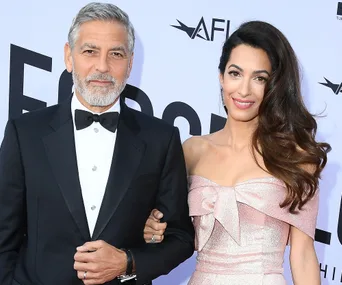Almost four years after they emerged into an Italian sunset as man and wife, the golden glow of George Clooney and Amal Alamuddin continues to wash over the world. Stylish, impeccably mannered and bathed in deadly cool, the Clooneys have become not just a source of fascination, but an object lesson in modern celebrity togetherness.
Anthropologists and relationship experts credit them with creating “a new paradigm” of marriage with the potential to sweep away old stereotypes and subtly reshape the way men and women think of each other.
The treacherous wastes of Hollywood’s romantic landscape may be littered with couples who learned too late that fame, money and beauty take you only so far, but the Clooneys appear to be more besotted with each other than ever.
From royal weddings to showbiz galas to the sanctums of power, square-jawed George, 57, and his brilliant 40-year-old wife are the guests everybody wants. The Hollywood Reporter magazine describes them as “the most talked about A-list couple in history,” but, until now, very little of the talk has come from the Clooneys themselves. Behind the screens of weeping willows that surround their magnificent English country house on an island in the River Thames, the pair have largely devoted themselves to raising their year-old twins, Alexander and Ella, and becoming good citizens of the sleepy parish of Sonning.
Recently, though, George and Amal have been opening up about themselves in a way that suggests they sense an obligation to share their happiness with their fans. At a glittering Hollywood tribute night to the actor in June, Amal, dressed in shimmering pink Prada, took to the stage to put her feelings on record. Admitting that she had once been “resigned to the idea that I’d stay a spinster”, the Lebanese-born human rights lawyer delivered a lengthy appreciation of her husband’s goodness and generosity, before turning to him, arms outstretched, and declaring: “My love, what I have found with you is the great love I always hoped existed.” At which point, George burst into tears.
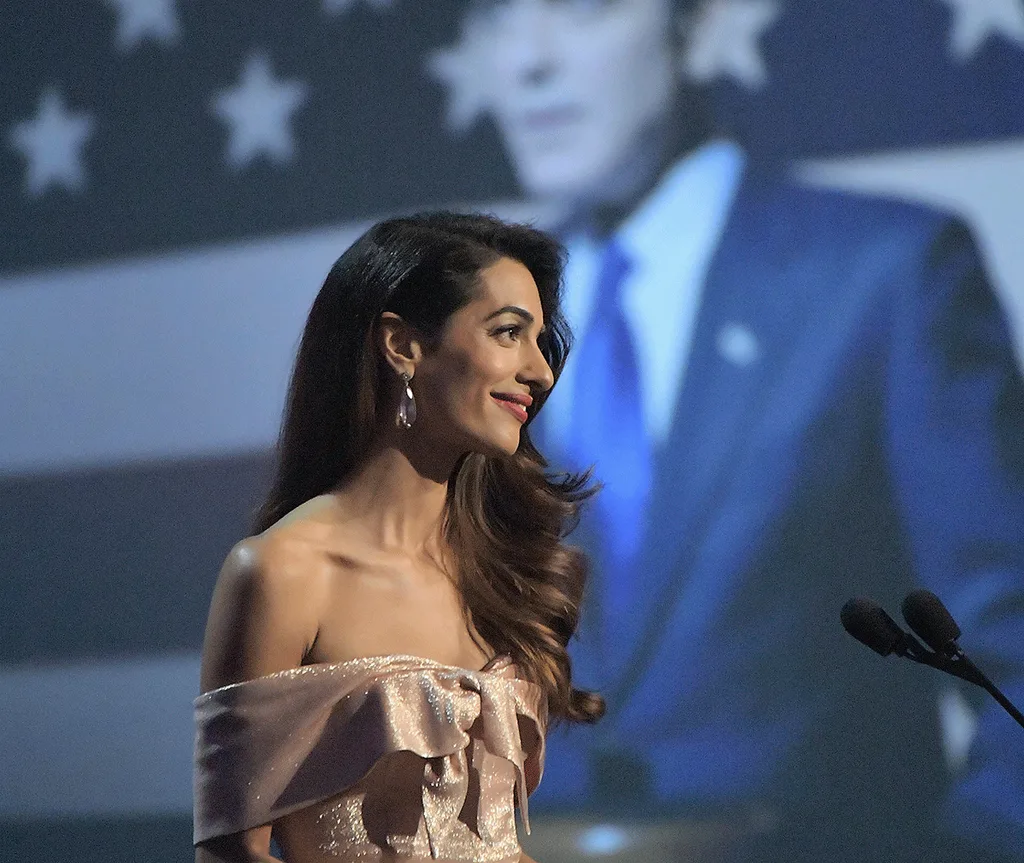
Amal onstage in June at the American Film Institute Life Achievement tribute to her husband, George Clooney, in Hollywood, where she publicly professed her love for him.
By the time he had recovered, George was on stage for his own speech, which concluded in similar vein: “It’s a humbling thing when you find someone to love,” he said. “Even better when you’ve been waiting your whole life, and your life is 57 years. Amal, whatever alchemy it is that brought us together, I couldn’t be more proud to be your husband.”
For all the mutual adoration, marriage to a movie megastar hasn’t been entirely without complications for Amal. She acknowledges that her life has changed “dramatically” since that spectacular wedding in Venice, attended by the likes of U2 singer Bono, actor Matt Damon and fashion maven Anna Wintour. Her courtroom appearances – once noted in the small-print pages of legal digests – are now news events in their own right, and the talks she gives are packed with movers and shakers.
The bright side, she says, is that her new fame brings attention to issues that might otherwise be ignored: “Sunshine is the best disinfectant,” she explained in June to an audience in Toronto.
She has taken on opponents ranging from the British government to ISIS, worked as an advisor to the United Nations, represented WikiLeaks founder Julian Assange, and attributes her concern for human rights to her own childhood experience as a refugee. London solicitor Mark Stephens, who has worked regularly with her, says she has “a Rolls Royce mind and a wonderful heart”.
Yet for a long time, the heart went unclaimed. Born in Beirut, Amal was two when her family fled the Lebanese civil war, eventually settling in a small town in southern England. She shone at school, won a place to study law at Oxford University and now practices as a highly-paid barrister at London’s most fashionable law firm, Doughty Street Chambers. Yet for all her brains and blazing beauty, she had reached her mid-30s without finding true love. A friend from her Oxford days recalls: “She had a bit of a tendency – I don’t want to sound ungallant – to bang on about human rights and that kind of stuff even at people’s birthday parties or end-of-term dinners when the rest of us were simply trying to get plastered. So a lot of chaps who fancied her also found her fairly hard going.”

For his part, George had virtually made a second career out of avoiding matrimony. Outrageously handsome and charming, he had smooched with starlets and canoodled with covergirls, but – beyond a fleeting early marriage to television actress Talia Balsam – had remained resolutely single.
It was while both were on what looked like a trajectory to lasting singledom that they met. The fateful event, as George only recently revealed, took place at his 18th-century Italian villa on Lake Como, where Amal had tagged on to a friend’s invitation to visit.
“Of course, she was beautiful,” George told Vogue magazine. “But I also thought she was fascinating, and I thought she was brilliant. Her life was incredibly exciting – the clients she was taking on and the superhuman work she was doing. I was taken with her from the moment I saw her.”
Amal was just as smitten: “We met and started hiding out at my London flat,” she recalled, “and very soon it felt like, no matter what happened, I would never want to be with anyone else.”
Their mutual interest in human rights – George has given millions of dollars to charitable organisations and good causes – clearly helped, but it seems to have been an improbable fondness for giraffes that finally sealed the deal. In early 2014, the pair went on a wildlife trip to Kenya.
“Amal loves giraffes,” George explained. “They’re her favourite animal. She went to this place called Giraffe Manor, where the giraffes put their heads through the windows and kiss you.”
Back in Los Angeles, he showed the photos to his best friend, TV director Ben Weiss.
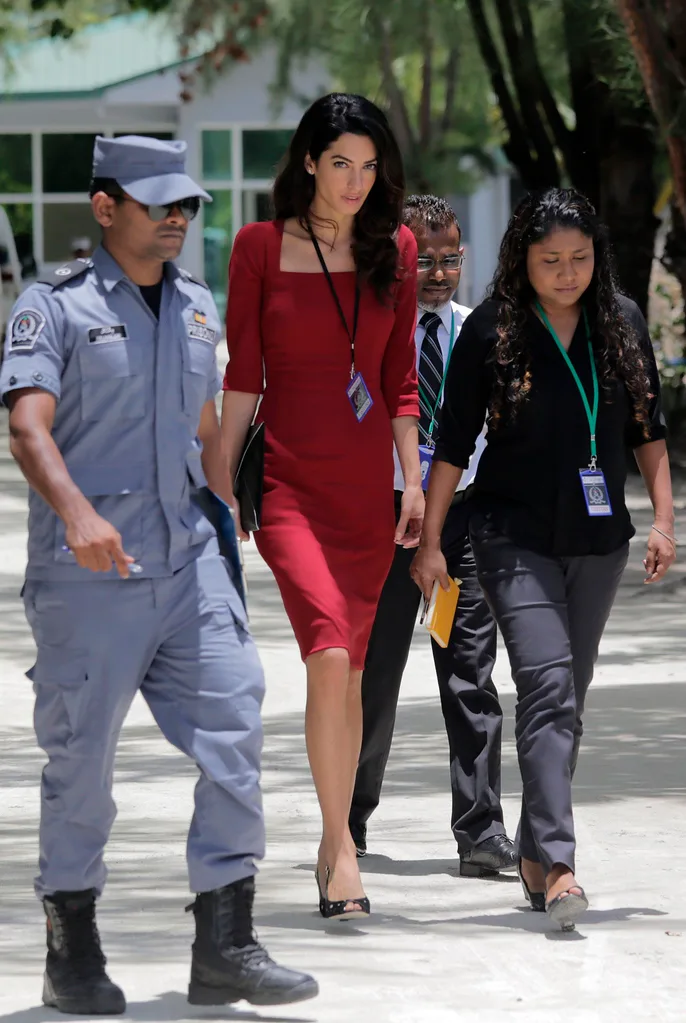
Human rights lawyer Amal leaves a prison in the Maldives after visiting former president Mohamed Nasheed.
“I said, ‘I think I’m going to ask her to marry me,'” said George. “And Ben said, ‘I think that’s a good idea.'”
Taking a cue from the giraffes, George stuck his neck out and proposed.
Sonning, 70 kilometres west of London, has a smattering of well-known residents, including Led Zeppelin guitarist Jimmy Page, magician Uri Geller and Britain’s prime minister, Theresa May, but it is hardly Celebrity Central, and most of its expensive riverside houses are discreetly owned by bankers, diplomats and corporate executives.
George stumbled upon the place while making his hit movie Monuments Men at the nearby Pinewood Studios. By happy chance, Amal knew the village too, having grown up barely half an hour away at Gerrards Cross.
The property they settled on, Aberlash House, was a nine-bedroom Georgian mansion, priced at $19 million and described by the selling agents as offering: “understated grandeur, set against the tranquil backdrop of magnificently wooded grounds”. It has taken many millions more, almost two years of work and some careful assuagement of local anxieties to turn it into the resplendent pile that now greets visitors.
Although the Clooneys have several other homes – Lake Como, an apartment in New York and what Amal calls a “low-key” house in Los Angeles (a hacienda-style spread once owned by rock star Stevie Nicks) – Sonning is their main base and, according to local council chairman David Wooding, they have made a serious effort to be good neighbours.
“Obviously there was some concern about the level of attention they would attract, and the security they wanted,” he says. “But it’s all been amicably resolved and most people are happy to have them here.”
From what we know of the interior, the Clooneys are big on photographs, with hundreds displayed around the house, mostly featuring themselves and their famous friends. Their taste in art is more quirky, with several paintings of George’s deceased spaniel, Einstein, in a variety of poses, including as a physics professor at a blackboard.
They have commissioned their own “G&A” monogram, which adorns everything from their matching terrycloth bathrobes to Amal’s hat boxes. To the couple it is, apparently, a symbol of their shared identity.
No hint of patriarchal preferment is allowed in this household. George and Amal both have offices on the first floor. His is clubbier, with overstuffed leather furniture; hers airier, piled with books and legal papers, and her barrister’s wig sits on a stand by the window. They share, as far as possible, the care of their twins, backed up by a team that includes a nanny, a chef and various assistants. George, who dropped out of college, may have more money, but he happily admits that Amal has a big lead in brainpower.
“She’s the professional, I’m the amateur,” he says.
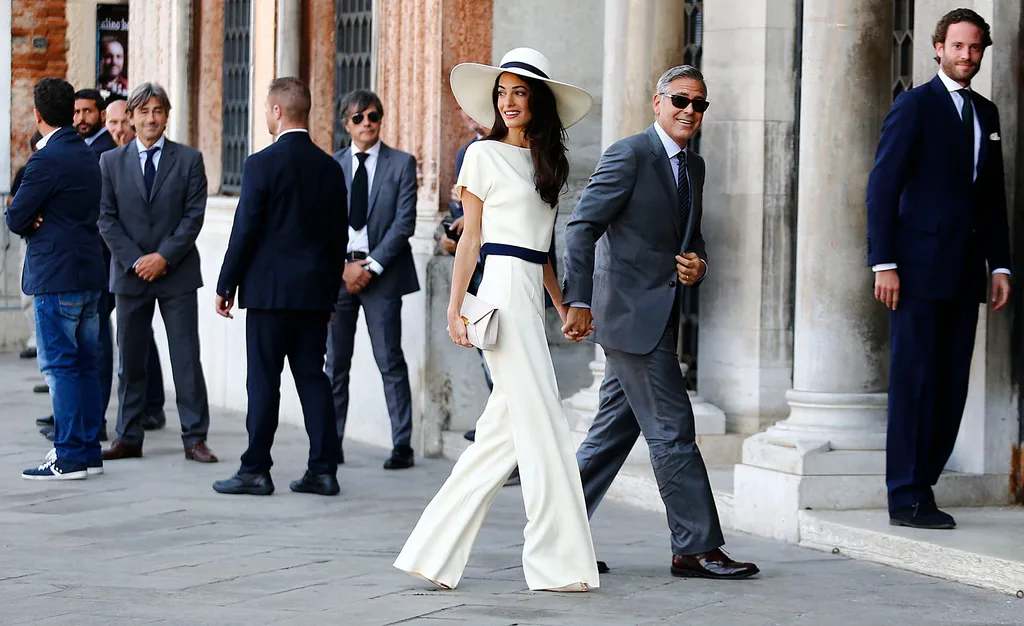
The happy couple arriving for their civil ceremony in Venice in 2014.
The Clooneys, who were star guests at the May wedding of Prince Harry and Meghan Markle (now the Duchess of Sussex), are not only friends of the younger royals, but share some of the same objectives. They want their children to have “normal” childhoods beyond the public gaze, and to be on the side of good in the world without being overtly political.
“Character traits like persistence, ambition, inquisitiveness and grit – that will determine your success,” Amal recently told the graduation class of a US university. “However, the thing that will define you as a person is your courage. That is the virtue on which all others depend.
“We need young people with the courage to say, ‘This is our world now and there’s going to be some changes.’ Be courageous. Challenge orthodoxy. Stand up for what you believe in. When you are in your rocking chair talking to your grandchildren many years from now, be sure you have a good story to tell.”
According to American social anthropologist, Dr Helen Fisher, author of an annual survey of relationship patterns, the Clooneys represent a new style of marriage. The old assumption that men were afraid of successful, intelligent women and secretly longed for attractive partners who would let them make the big decisions is disappearing, she says. Of the 5600 single men questioned, 87 per cent said they would be happy to marry a woman who was better educated and earned more money than they did.
The survey calls this “the Clooney Effect”.
“Like George, men are increasingly seeking a different type of woman,” says Dr Fisher. “Someone who is smart, powerful and self-sufficient. It’s a great step forward.”
Nor are they afraid to sing each other’s praises.
George says of Amal: “She’s an amazing person and she’s caring and one of the smartest people I’ve met and she’s got a great sense of humour.” At the American Film Institute gala, Amal replied that “as well as being nominated for more awards than any human being on the planet,” George was driven by a desire to do good in the world. “George shows us all what it is to have a moral conscience. Although he modestly attributes most of his success to luck, I think it is his incredible talent and character that got him here and these attributes make him an amazing husband and father.”
Four years isn’t an age even in Hollywood, but there are encouraging signs the Clooneys have successfully re-booted the concept of celebrity marriage. “First and foremost, they are a team,” says British author and celebrity relationship expert, Sloan Sheridan-Williams. “They know what works for them, and they keep applying the same successful principles over and over. They love to spend time together, travel together, create similar interests together, be with family together, so their physical proximity becomes an emotional one.”
The Clooneys may have other advantages. “The biggest flaw in relationships is fear,” says Sloan. “Fear of rejection, intimacy, commitment, abandonment. George and Amal were extremely self-disciplined people even before they met, which is how they got on in their careers. Self-discipline works two fold: firstly because it allows couples to work well together, but it also allows them to draw clear lines of what they are willing and not willing to accept. This clarity and consistency early on in a relationship is a perfect foundation for a successful marriage.”
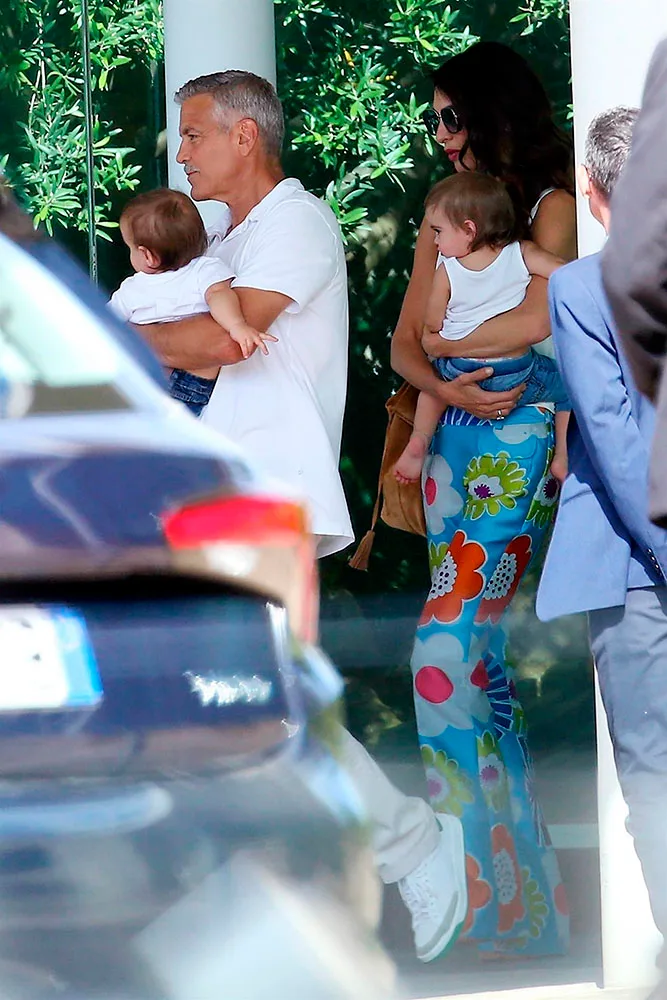
The Clooneys with their one-year-old twins, Alexander and Ella, have homes around the globe.
Not quite everything is perfect for the couple. They profess not only to dislike, but be bewildered by all the attention they receive. Raised in rural Kentucky, George affects a disarming kind of “aw shucks” astonishment when asked what it is like to be so famous and well-connected.
“I don’t think of us as a power couple,” he says. “I don’t even know what that is. I’d guess the Clintons [both close friends, naturally] are a power couple.”
And although Vogue assures us Amal is “at peace with the balance of fashion in her life”, she seemingly struggles to see why every outfit she wears and every appearance she makes is subjected to such minute scrutiny.
One answer may be that, while the Clooneys appear radical and different, they are also a throwback to an older and better form of celebrity. The great stars of the past traded not just on their fame, but on class, grace and decency. If the most feted couple of the modern world can give us that too, “The Clooney Effect” will only grow in power.


